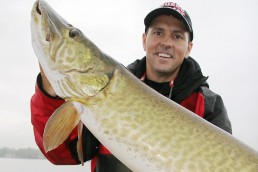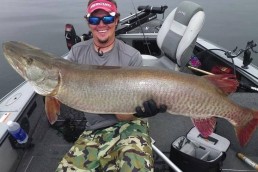Number One Key to Early Season Muskies
SHARE THIS POST
Springtime muskie trips are filled with hope, anticipation and excitement—like any typical muskie outing. Yet results are often few and far between when conventional tactics are employed. Joe Bucher shares what he believes may be the number one key to early season muskies.
Early Season
Spring muskie success usually requires specialized gear and an approach that respects the uniqueness of the spring period. Specifically, the transitional/seasonal change from winter to spring, accompanied by increasing amounts of daylight and warmer temperatures, triggers an urge in muskies that goes far beyond filling their bellies.
Instead, spring muskie behavior often focuses on migration toward suitable spawning sites. Muskies are certain to snatch up meals along this migration. Once they arrive at their breeding locations, the best spring strategy is to locate spawning sites first. This might sound like a daunting task, but my experiences suggest it all comes down to one simple key—warm water. This why a temp gauge can be your most important piece of electronic gear during spring outings.
Warming Trend
Generally, no matter what the cover, terrain, topography or bottom content is, if noticeably warmer water exists in a specific region on the lake, there are bound to be active spring muskies present. I am not implying that all the muskies in one given water system are where warm water is, but it’s a good bet that the ones using that particular area are sure to be much more active. Weather and time of day also have a bearing on muskie location, as well as their activity mood. This also includes sun exposure.
For example, a shallow northeastern portion of any given body of water might have cold water temperatures in early morning, particularly after a chilly night. However, a full day of sun exposure and solar heat is sure to warm that area up a bunch by late afternoon. If the wind direction is northerly, allowing this area to remain calm, water in a cove or on a shallow flat might warm up by as much as 10 degrees! This northern exposure rule works to a “T” whenever there is ample sunlight and a lack of cold wind and wave action. Any muskie inhabiting this bay would most likely be non-active early in the day. In addition, the rest of the food chain that services this muskie is not likely to be active early, as well.
Are you enjoying this post?
You can be among the first to get the latest info on where to go, what to use and how to use it!
Research
A periodic check of solar-exposed areas throughout your day of fishing often reveals startling developments when the conditions are right. This same bay, dead and lifeless in the morning, may now have minnows cruising the warmed surface waters. They will be feeding on algae and protozoa that also just came to life with the warming water temps. It might also have a few bass, crappies and perch chasing these minnows, causing a visible surface disturbance. All of this, in turn, also draws in muskies. It’s the place to be in springtime when following this number one key to early season muskies!
Watch our epic Lake Michigan Musky Trip!
Become a MidWest Outdoors Insider here!
MWO
SHARE THIS POST
Did you enjoy this post?
You can be among the first to get the latest info on where to go, what to use and how to use it!
Joe Bucher
Joe Bucher is a Freshwater Fishing Hall of Fame Legendary Angler, book author, lure designer and host of Fishing with Joe Bucher TV series.



